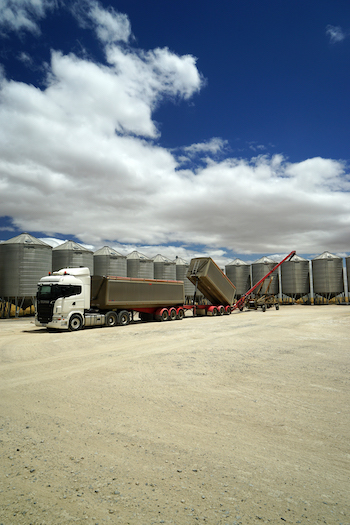The Rethus family, who farm near Horsham in Victoria, are known locally for being innovative, trying new ways of doing things and embracing technology. When it comes to on-farm grain storage, the approach is no different.
After running an on-farm grain storage workshop at the Rethus’ farm in 2019, GRDC grain storage extension team leader Chris Warrick caught up with Tim Rethus to see what he is doing with on-farm storage.
Tim and Luke Rethus, along with their father, families and staff, are third-generation growers near Horsham. It is predominantly a winter, rain-fed farm producing cereals, legumes and oilseed grains and exporting oaten hay.
The Rethus’ farm is located near several grain receival sites (bulk handlers) and, historically, there has not been much need for on-farm storage. As the farm expanded, they initially began investing in on-farm storage for seed, and then for legumes as they became part of the rotation.
Today’s on-farm storage
Now operating two harvesters and two B-doubles, the Rethuses find keeping grain away from the paddock at harvest a challenge through the bulk handler system.
The Rethus family have recently invested in four large, flat-bottom silos to store cereals and their 24 original 80 to 100-tonne cone-bottom silos are still used for seed and legume storage. As well as harvest logistics, the strategy to invest in on-farm storage has also been to spread marketing risk.
A portion of grain can be forward-sold, a portion sold at harvest for cash flow, and a portion held for marketing throughout the year. Some niche grains such as durum require storage for direct marketing throughout the year. The Rethuses have worked on building relationships with regular customers and have done some blockchain selling direct to customers to enable origin traceability.
Tim suggests that well-designed grain storage allows management options and recommends growers seek good advice before investing. “Choosing the right storage is something you learn – the value in getting the right type of storage for your system and the right manufacturer that can produce the quality you want for gas-tight sealing and aeration systems.”
Grain storage is a significant investment, so compromises are often made. The Rethuses were adamant that any cost-cutting compromises could not jeopardise long-term options to manage grain in storage.
Managing on-farm storage
While the Rethuses have plenty of segregations in their on-farm grain storage, having only one fill auger long enough to reach into their large flat-bottom silos makes it challenging. The logistics of switching segregations per truck load are unviable, so they aim to make each paddock grow a consistent grade and test every truckload for moisture and protein.
Monitoring is something Tim identified that most growers could do better, noting the frequency of in-crop monitoring and the lack of in-storage monitoring. The availability of technology suitable to Australian storage and fumigation practices is limited when compared to the technology available for in-crop monitoring and management.
Tim is enthusiastic about developments in the area of traceability. The Rethuses go to what they say is a lot of effort with their farming system to grow the best grain in a way that is good for the environment, so it makes sense to provide that information to buyers so grain can be marketed as a specific quality. “Traceability incentivises us to do more good things for our farm and our soil,” he says.

In Tim’s view, grain classification is largely based on protein and screenings. Buyers are asking for more quality parameters such as nutrient density, which is not currently segregated for.
“If buyers are willing to pay for grain of a specific quality or grown in a particular way, that’s difficult to achieve through a bulk handler,” he says. The Rethuses have started supplying grain to customers wanting a specific quality, but Tim says the two challenges are growing it to that quality and testing the quality characteristics.
When asked about the role of bulk handlers in the future, Tim thinks they will always have a place. “Segregation and traceability are a real advantage of on-farm storage, but there’s no reason the bulk handlers couldn’t be a part of that.”
He describes a system where growers store grain on-farm on behalf of the bulk handler, who could then call on a network of segregated grain across numerous farm sites to meet market requirements.
A notable challenge would be ensuring growers test and classify grain accurately, so each site is consistent, and that quality is managed during storage. He acknowledges that bulk handlers have a lot more to lose reputation-wise than individual growers if grain quality or storage management are not as buyers expect.
Consistency of grain testing among bulk handler sites with trained operators varies, to the point where Tim says the same truckload of grain can achieve different grades at different sites. “The more that testing can be automated, the more opportunities for consistency when delivering to bulk handlers or storing on farm.”
Logistics issue
Tim suggests port logistics are a critical problem that is costing Australian growers a lot of money. “Typically, getting grain from the paddock to on-farm storage is not a problem – from farm to bulk handlers is slow but OK, but there seems to be a bottleneck getting grain from bulk handlers to ports.”
In recent years, significant margins have been left uncaptured when Australian grain has been underpriced by $100/t because it could not physically be exported.
More information: Chris Warrick, Call 1800 WEEVIL, info@storedgrain.com.au

























































